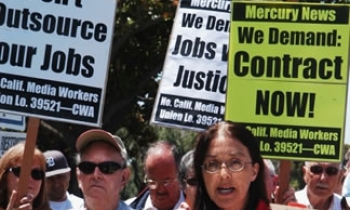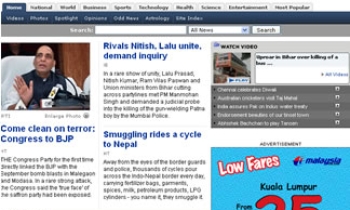Most advertising industry leaders in the US believe that Fortune 500 companies are "generally behind the curve when it comes to online ad strategy." There is also a wariness of advertising executives regarding their own ability to keep pace with the changing digital environment. Fifty-eight per cent feel that they personally are "struggling simply to manage existing online efforts, let alone stay ahead of the curve."

According to the American Advertising Federation (AAF) Survey of Industry Leaders on Digital Media Trends, an overwhelming majority of those surveyed recognise the effectiveness of digital marketing, with 91 per cent citing the online media environment as "empowering to advertisers, allowing the ad industry to shape its own development." Digital media's high return on investment (ROI) was also recognised by those surveyed, with 42 per cent citing paid search as offering the highest ROI platform.
Advertising executives find blogs a riskier, less effective advertising vehicle than user-generated content sites such as MySpace, YouTube, Facebook, etc. Sixty-two per cent said that "blogs are too risky to advertise with due to lack of predictability of the editorial content," while only 53 per cent agreed with the same statement about user-generated content. Despite these concerns, an overwhelming majority said advertisers "should exploit the viral marketing opportunities" of user-generated sites and, to a lesser degree, blogs.
The AAF study surveyed 140 advertising industry leaders, spread across agency (23 per cent), media (28 per cent), client (7 per cent) and others (22 per cent, composed mostly of consultants and researchers) sectors; 60 per cent had worked in the advertising industry for over 15 years (30 per cent for +25 years).
AAF, headquartered in Washington, acts as the "Unifying Voice for Advertising." AAF is the oldest national advertising trade association in the US, representing 50,000 professionals in the advertising industry. AAF has a national network of 200 ad clubs located in ad communities across the country. Through its 215 college chapters, AAF provides 6,500 advertising students with real-world case studies and recruitment connections to corporate America.
Advertising industry leaders forecast expanded ad budgets across online media as a whole, as well as most digital media platforms
- Average spending on online advertising, as a percentage of the total media budget, is anticipated to increase from 15 per cent in 2005 to 20 per cent in 2006, and forecast to reach 32 per cent by 2010
- New media platforms will only get a small percentage of online budgets next year, with social media and video getting the top percentage of spend
- Average spend of the online budget over the next year: 7 per cent on social media, 5 per cent on online video, 4 per cent on podcasts, 2 per cent on blogs, 2 per cent on mobile devices and 1 per cent on advergaming
- The average budget allocation to paid search is set to increase from 9 per cent of the online budget in 2005 to 11 per cent in 2006 and 23 per cent in 2010
- Display advertising is set to increase over the next year: 22 per cent of the online budget in 2005 to 28 per cent in 2006, but decrease by over half to 13 per cent by 2010
- Rich media will increase from 11 per cent in 2005 to 13 per cent in 2006 and 18 per cent in 2010; dedicated/other email advertising will experience the slowest growth from 8 per cent in 2005 to 11 per cent in 2006 to 13 per cent in 2010
- Respondents said that they are willing to pay a 14 per cent premium for behavioral and demographic targeting services for online ads
Advertising industry leaders are generally optimistic on the industry's relationship with digital media, but wary of their own ability to keep pace with the changing environment:
- 91 per cent cite the online media environment as "empowering to advertisers, allowing the ad industry to shape its own development"
- Only 29 per cent said that the "overwhelming uncertainty of the online media environment makes me hesitant to move ad dollars there"
- Less than half (46 per cent) cited the online media environment as creating "a loss of control for advertisers, with the majority struggling just to keep pace"
- However, 58 per cent said that they personally are "struggling simply to manage existing online efforts, let alone stay ahead of the curve"
Advertising industry leaders see online advertising as increasingly expanding into the traditional advertising sphere, but say that Fortune 500 companies lag behind:
- 71 per cent disagree with the statement that "the majority of online advertising will continue to be advertisers whose products/services are sold online"
- However, 63 per cent believe that Fortune 500 companies are "generally behind the curve when it comes to online ad strategy"
- While 73 per cent of advertisers say that "Fortune 500 companies are more likely to spend the majority of their ad budgets on display rather than search ads," 63 per cent do not believe that "as branding becomes more of a priority, advertisers will spend relatively fewer dollars on paid search"
Advertising industry leaders attribute a higher ROI to digital media than traditional media, with paid search as the highest ROI platform
- 73 per cent see digital media as providing more ROI than traditional media
- 42 per cent cited paid search ads as having the highest ROI, 24 per cent for dedicated or other email ads, 16 per cent for rich media ads, and 9 per cent for display ads
Advertising industry leaders generally have a more positive view of user-generated content sites (MySpace, YouTube, Facebook, etc) than blogs
- While 24 per cent have advertised on a blog and 7 per cent plan to do so in the next year, 19 per cent have advertised on a user-generated content site, and 14 per cent plan to do so in the next year
- Blogs are considered to be relatively riskier than user-generated content sites, with 62 per cent agreeing with the statement that "blogs are too risky to advertised with due to lack of predictability of the editorial environment," and 53 per cent agreeing with the same statement about user generated content
- 76 per cent were concerned about "the ability to control brand/product image" on blogs, as opposed to 67 per cent for user-generated content sites
- While 70 per cent said that blogs are "useful for niche advertising, but will not have an effect on major accounts," only 41 per cent agreed with the statement when applied to user-generated content sites
- 91 per cent said that advertisers "should exploit the viral marketing opportunities" of user-generated content sites, while 81 per cent said the same of blogs
While online video provides more advertising opportunities, it has not yet had a significant impact on ad spend with television network upfront markets
- 93 per cent said that video and other rich media ads provide more creative opportunities for online advertising
- Of those who participate in TV upfront markets, 62 per cent said online video (either rebroadcast or original content) did not have an effect on their spend with networks, 15 per cent said online video decreased their network spend while 23 per cent said it expanded their spend with networks









